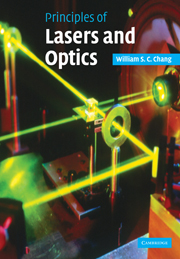Book contents
- Frontmatter
- Contents
- Preface
- 1 Scalar wave equations and diffraction of laser radiation
- 2 Gaussian modes in optical laser cavities and Gaussian beam optics
- 3 Guided wave modes and their propagation
- 4 Guided wave interactions and photonic devices
- 5 Macroscopic properties of materials from stimulated emission and absorption
- 6 Solid state and gas laser amplifier and oscillator
- 7 Semiconductor lasers
- Index
- References
6 - Solid state and gas laser amplifier and oscillator
Published online by Cambridge University Press: 06 July 2010
- Frontmatter
- Contents
- Preface
- 1 Scalar wave equations and diffraction of laser radiation
- 2 Gaussian modes in optical laser cavities and Gaussian beam optics
- 3 Guided wave modes and their propagation
- 4 Guided wave interactions and photonic devices
- 5 Macroscopic properties of materials from stimulated emission and absorption
- 6 Solid state and gas laser amplifier and oscillator
- 7 Semiconductor lasers
- Index
- References
Summary
Rate equation and population inversion
In a material which has only two energy levels, χ″ is always positive because ρ11 > ρ22 for E1 < E2 at thermal equilibrium. Prior to the invention of lasers, there was no known method to achieve ρ22 > ρ11. However, we now know that a negative χ″ in Eq. (5.41a) (i.e. ρ22 > ρ11) can be achieved by pumping processes that are available in materials that have multiple energy levels, as described in the following.
Let there be many energy levels in the material under consideration, as shown in Fig. 6.1. Let there be a mechanism in which the populations at E1 and E2, i.e. N1 = Nρ11 and N2 = Nρ22, are increased by pumping from the ground state at pump rates R1 and R2. In solid state lasers, the pumping action may be provided by an intense optical radiation causing stimulated transition between the ground state and other higher energy states, where the particles in the higher energy states relax preferentially into the E2 state. In gas lasers, the molecules in the ground state may be excited into higher energy states within a plasma discharge; particles in those higher energy states then relax preferentially to the E2 state. Alternatively, collisions with particles of other gases may be utilized to increase the number of particles in the E2 state. Various schemes to pump different lasers are reviewed in ref. In order to obtain amplification, it is necessary to have R2 ≫ R1.
- Type
- Chapter
- Information
- Principles of Lasers and Optics , pp. 179 - 211Publisher: Cambridge University PressPrint publication year: 2005

